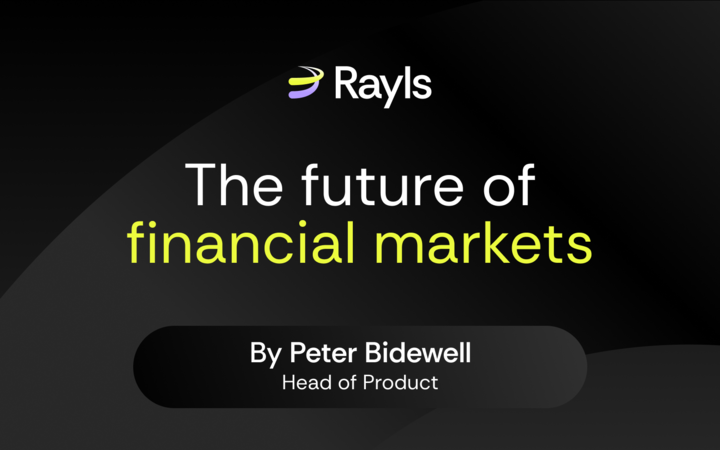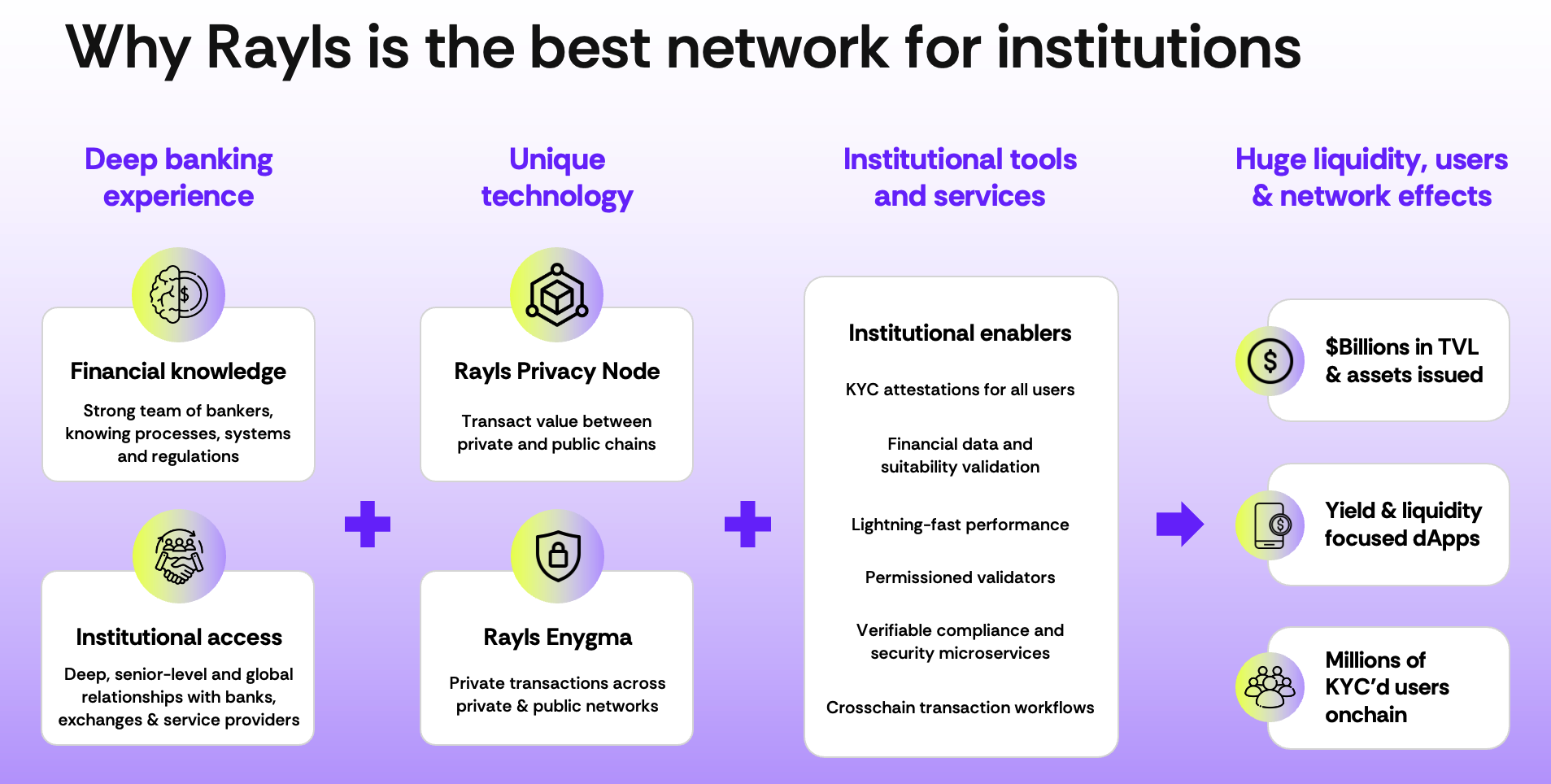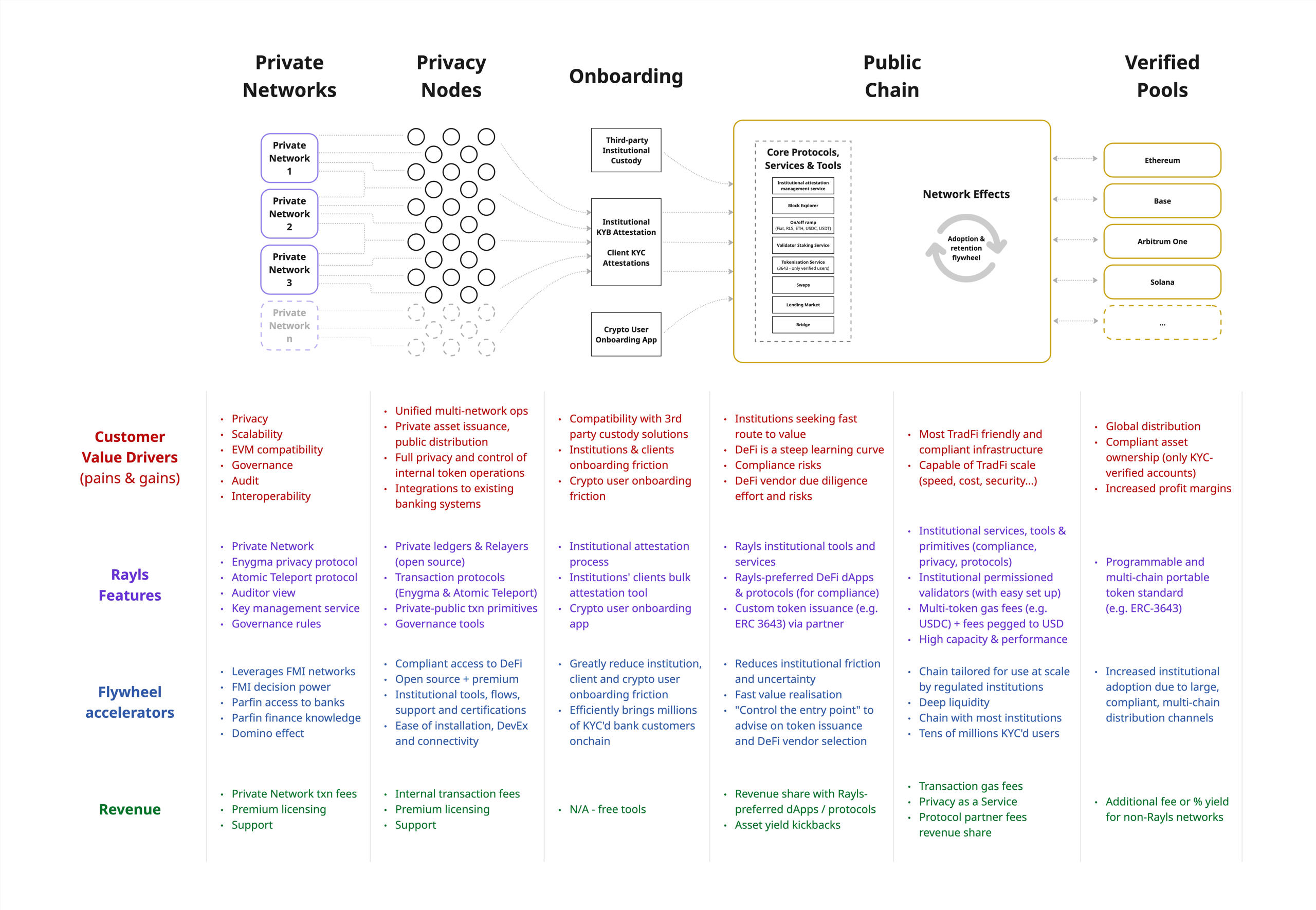The future of financial markets with Rayls

Rayls is the blockchain for banks and financial institutions.
Our goal is to enable institutions to use blockchain technologies to privately tokenise assets, securely connect into public DeFi and compliantly trade with other institutions and global DeFi crypto users. By connecting these two worlds into one ecosystem, Rayls powers a range of new use cases, workflows and revenue opportunities.
While other blockchain projects focus on taking value and users from the existing crypto markets (~300M users, ~$3T DeFi liquidity), Rayls will become the next generation of global financial market infrastructure that brings net new liquidity and users from traditional financial markets (6.2B users, $100T+ liquidity).
For DeFi users and builders, this means a huge influx of TradFi capital with lower risk and deeper liquidity, tens of millions of new potential customers per bank onboarded and entirely new high yield opportunities from financial assets that were previously inaccessible to a global retail audience.
To give this some scale, Citi, as an example of just one bank, has 200 million customer accounts across 160 countries and $2.4T in total assets… roughly the entire user base and value of the whole of the crypto markets today.
What problems are we solving?
Institutions see the opportunities of DeFi (new revenue, global buyers, low cost), but are inhibited from using public blockchains at scale and connecting them to their existing banking systems, due to their must have requirements:
- Compliance - KYC/KYB, buyer suitability criteria, regulatory oversight
- Privacy - retaining competitive advantage and security means transaction data and balances cannot be publicly visible
- Scalability - banks need systems that can service tens of millions of customers, process trillions of dollars in transaction value and complex workflows, without risk of failure or congestion
- Cost - banks compare to existing costs, so fees must be similar or cheaper
- Risk - high risks due to anonymous users, public attack surfaces, emerging technologies (bugs), no authority recourse
- Control - banks want full control of their own infrastructure and operations, giving them flexibility to manage their own business and easily integrate with other systems / networks as they prefer
Why have others failed?
Blockchain providers have tried to engage institutions by adapting their public chains to institutional use cases, or by offering permissioned blockchains for institutional use.
Both approaches have failed because they only meet some, but not all, of the above institutional requirements.
Why Rayls will succeed
The Rayls team has deep experience across both traditional financial markets and crypto. With this experience we have designed Rayls to satisfy all the must have institutional requirements and give access to the benefits of DeFi.
The Rayls team also has direct access to banks with deep, longstanding relationships with bank executives from across the world. This access exposes the value that Rayls can bring to decision makers and demonstrates Rayls as the ideal choice when selecting a blockchain platform for institutional use.
As described by Andrew Chen, General Partner at a16z, in his 2021 book “The Cold Start Problem”, companies building complex double-sided ecosystems should “start with the hard side” (e.g. asset issuers, sellers) with “network density” (e.g. a key market, like Brazil) and then the ecosystem will grow.
By removing institutional barriers and amplifying access to tokenisation and DeFi benefits, Rayls acts as a catalyst the bring billions of institutional customers and trillions of dollars worth of assets onchain and connect with DeFi.

What are we building?
Rayls is comprised of 4 core products:
- Rayls Privacy Node - each bank installs their own private, permissioned EVM blockchain at their premises, enabling the bank to issue financial asset tokens and privately transfer them between millions of their internal client accounts. Privacy Nodes are high performance, single-node and use an enterprise-grade database for added security.
- Rayls Private Network - Several Privacy Nodes can privately connect to one another through an independent Private Hub permissioned chain to create a Rayls Private Network. This hub and spoke model of independent chains ensures full privacy, network governance, auditability and scalability.
- Rayls Public Chain - Privacy Nodes and Crypto Users can connect to the Rayls Public Chain, an Ethereum-compatible Layer 1 public chain, where all accounts have been verified by a regulated institution. Other features to support institutional adoption include: fixed gas fees (removing fee volatility), multi-token gas fees (enabling banks to pay in stablecoins), permissioned validators (giving greater control to institutions), high transaction throughput, low transaction costs and private transactions using Rayls Enygma.
- Rayls Enygma - Enygma is an EVM private transaction protocol, which can be deployed in both Rayls Private Networks or the Rayls Public Chain to enable two Privacy Nodes to transact with privacy. Rayls Enygma uses zk-SNARKS and homomorphic encryption to provide privacy of balances, transactions and counterparties in a compliant way.

Rayls strategy
To achieve our goal of institutional adoption and stimulating enormous network effects, the Rayls product suite facilitates institutions to privately issue assets, securely trade between each other and then distribute them globally to verified retail buyers. Other capabilities reduce barriers to adoption and accelerate an institution’s time to value (e.g. tools to ease onboarding, preferred partners and use case accelerators).
Value is created for stakeholders at every stage of the journey, further accelerating the value and adoption flywheel for institutions, protocol builders and crypto users.
Consequently, revenue is also channelled to Rayls, enabling reinvestment into ecosystem development, market adoption and $RLS token holder value.
See below for how value flows and accrues across the Rayls private-public ecosystem.

Building traction
As with any complex multi-sided ecosystem, the success of our strategy revolves around incentivising stakeholder behaviour toward initial adoption and usage. Once an ecosystem has been established, network effects kick in to stimulate and accelerate further adoption.
To kick start initial ecosystem adoption, Rayls will focus on the following:
- Product excellence - meet all must-have requirements, differentiated features, low barrier to adoption, low running costs (Rayls must be the best choice for institutions)
- Institutional adoption of Privacy Nodes - engaging institutions to install and use Privacy Nodes, focusing on the “hard side” and “network density”, connecting to both Private Networks and Public Chain (increase customer awareness and intent)
- Remove onboarding friction - build / partner to provide core tools and primitives to onboard institutions fast (reduce barriers to adoption)
- Facilitate high value use cases - model most in demand use cases, demonstrate Rayls unique value, work with partners to create packaged offerings (accelerate institutional time to value)
- Build a strong DeFi community - nurture an engaged community of DeFi investors, protocol builders, users and token holders (develop a thriving, sustainable token economy)
Stay tuned
In upcoming posts, we will share more on:
- Details of each part of our product suite, including key differentiators and the business impact this delivers for institutional customers and the benefits for DeFi users, investors and builders
- Rayls institutional adoption, liquidity, TradFi asset issuance and DeFi distribution, with real-world examples
- Updates on our Public Chain Testnet and Mainnet, including unique capabilities and design choices to stimulate institutional adoption
- Institutional use cases and partnerships to stimulate adoption and bring net new liquidity and millions of users onchain
- How institutional adoption creates value for DeFi protocols and crypto users
- Rayls tokenomics and building a fully connected token economy across private and public chains
Subscribe to our newsletter




.png)